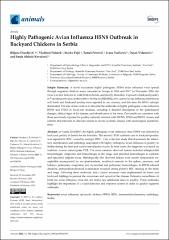| dc.contributor.author | Đurđević, Biljana | |
| dc.contributor.author | Polaček, Vladimir | |
| dc.contributor.author | Pajić, Marko | |
| dc.contributor.author | Petrović, Tamaš | |
| dc.contributor.author | Vučićević, Ivana | |
| dc.contributor.author | Vidanović, Dejan | |
| dc.contributor.author | Aleksić-Kovačević, Sanja | |
| dc.date.accessioned | 2023-02-17T10:06:21Z | |
| dc.date.available | 2023-02-17T10:06:21Z | |
| dc.date.issued | 2023 | |
| dc.identifier.citation | : Djurdjević, B.; Polaček, V.; Pajić, M.; Petrović, T.; Vučićević, I.; Vidanović, D.; Aleksić-Kovačević, S. Highly Pathogenic Avian Influenza H5N8 Outbreak in Backyard Chickens in Serbia. Animals 2023, 13, 700. https://doi.org/10.3390/ ani13040700 | en_US |
| dc.identifier.issn | 2076-2615 | |
| dc.identifier.uri | https://repo.niv.ns.ac.rs/xmlui/handle/123456789/593 | |
| dc.description.abstract | In winter 2016/2017, the highly pathogenic avian influenza virus H5N8 was detected in
backyard poultry in Serbia for the first time. The second HPAI outbreak case in backyard poultry
was reported in 2022, caused by subtype H5N1. This is the first study that documents the laboratory identification and pathology associated with highly pathogenic avian influenza in poultry in
Serbia during the first and second introduction waves. In both cases, the diagnosis was based on
real-time reverse transcriptase PCR. The most common observed lesions included subepicardial
hemorrhages, congestion and hemorrhages in the lungs, and petechial hemorrhages in coelomic
and epicardial adipose tissue. Histologically, the observed lesions were mostly nonpurulent encephalitis accompanied by encephalomalacia, multifocal necrosis in the spleen, pancreas, and
kidneys, pulmonary congestion, and myocardial and pulmonary hemorrhages. In H5N8-infected
chickens, immunohistochemical examination revealed strong positive IHC staining in the brain
and lungs. Following these outbreaks, strict control measures were implemented on farms and
backyard holdings to prevent the occurrence and spread of the disease. Extensive surveillance of
birds for avian influenza virus did not detect any additional cases in poultry. These outbreaks
highlight the importance of a rapid detection and response system in order to quickly suppress
outbreaks. | en_US |
| dc.description.sponsorship | This study was funded by the Ministry of Education, Science and Technological Development of the Republic of Serbia by the contract of implementation and funding of research work
of NIV-NS in 2022, contract no. 451-03-68/2022-14/200031, and by the Provincial Secretariat for Higher Education and Scientific Research, Autonomous Province of Vojvodina, project number
142-451-3170/2022-01/2. | en_US |
| dc.language.iso | en | en_US |
| dc.source | Animals | en |
| dc.subject | avian influenza | en_US |
| dc.subject | backyard | en_US |
| dc.subject | chickens | en_US |
| dc.subject | H5N8 | en_US |
| dc.subject | H5N1 | en_US |
| dc.subject | immunohistochemistry | en_US |
| dc.subject | pathology | en_US |
| dc.subject | Serbia | en_US |
| dc.title | Highly Pathogenic Avian Influenza H5N8 Outbreak in Backyard Chickens in Serbia | en_US |
| dc.type | Article | en_US |
| dc.identifier.doi | 10.3390/ani13040700 | |
| dc.identifier.doi | 10.3390/ani13040700 | |

